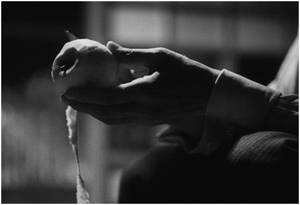August 24th Log
THAT NIGHT’S WIFE
1930, Yasujiro Ozu, Japan
1st Viewing, DVD
That Night’s Wife is a unique film from Ozu in that it is a suspenseful crime thriller, yet it stands among one of his most interesting silent films in the way it emerges into a definitely Ozu film. The simple story centers around an artist who steals money and is chased down by a police detective. When the detective arrives at his home, he is held at gun point by the artists wife. The film is reminiscent of a Hollywood thriller, but the emotional and visual core is purely Ozu, particularly the way the film is concentrates in family and social troubles, as the penniless artists robs the money to pay for medicine for his sick daughter. That Night’s Wife takes place almost entirely within the apartment, and the mood is effectively established as tense and claustrophobic. What truly makes the film definitive Ozu is the rhythm, captured by lyrical visual patterns. Here Ozu uses expressive tracking shots as visual patterns, as well as a specific use of hand expressions to heighten the atmosphere and suspense. Ozu flawlessly edits the visual patterns and motifs resulting in a film that is at once tense, stunning, and poetic. That Night’s Wife is likely to be forgotten among Ozu’s more emotionally-driven silent films, but it remains a truly fascinating work from the master.
>>> More on That Night’s Wife @ A2P Cinema's Yasujiro Ozu website HERE
>>> A clip from from That Night’s Wife:
INLAND EMPIRE
2006, David Lynch, France / Poland / United States
Repeat Viewing, DVD
I had to give this film another viewing. Not so much to unravel it’s mysterious, because David Lynch does not necessarily create the film as a form of narrative explanation but rather a bizarre journey into a dreamworld of vast possibilities beyond rational interpretation. Narratives are not cohesive and time frame overlap. The film is perhaps many things, but I think at the core is the subconscious state of Nikki, most specifically her struggle with art (which is role playing). This is heightened by an unbelievably complex performance from Laura Dern, who is masterfully working on multiple levels. The glorious beauty (beautiful to me at least) of the film fully emerges in its ending, which leaves the viewer into a state of almost spiritual transcendence as all the mysteries seemed contained within the final closeup of Dern’s face, and a final exhale of “sweet”, followed by an incredible dance credit sequence to Nina Simone’s Sinnerman. This film has a spell on me and I expect yet another viewing will be coming soon…



0 Comments:
Post a Comment
Subscribe to Post Comments [Atom]
<< Home